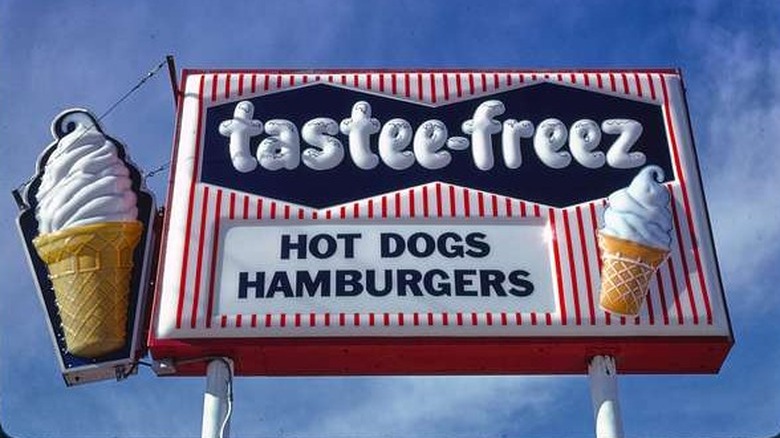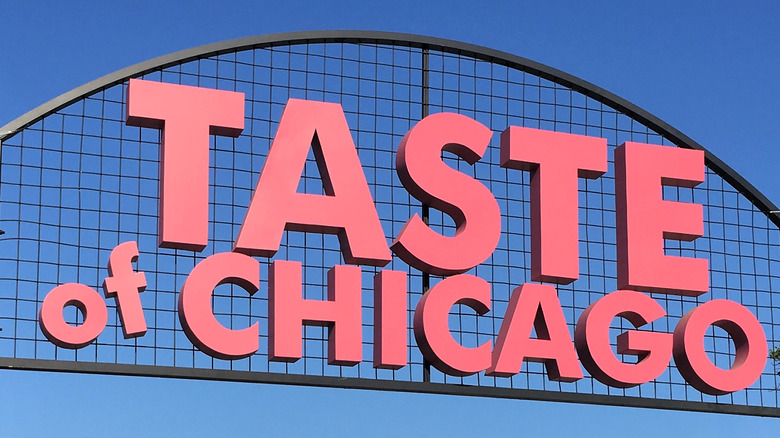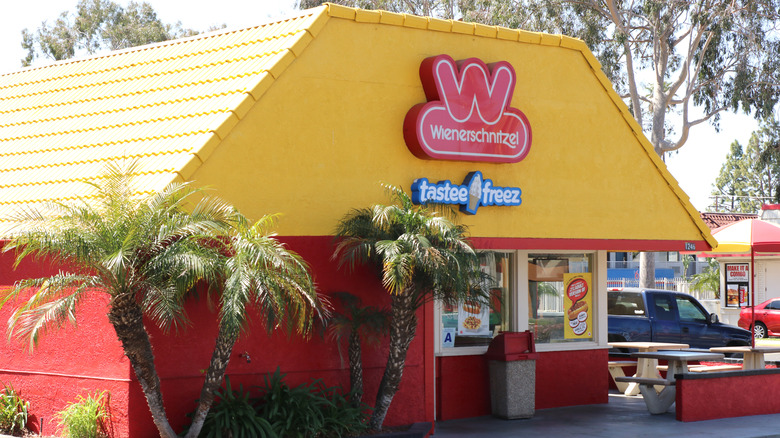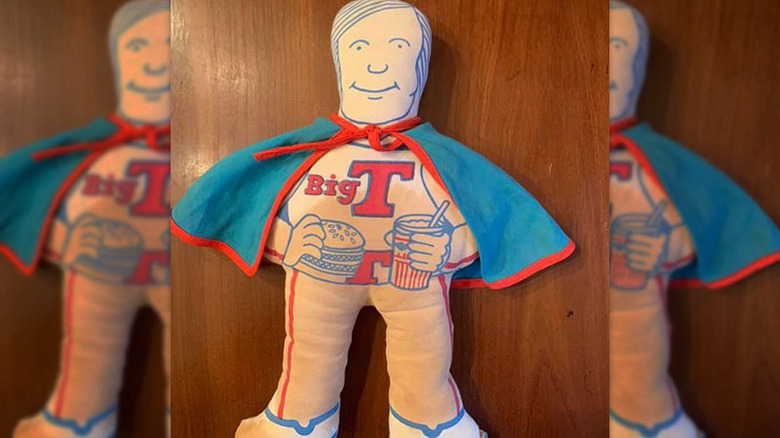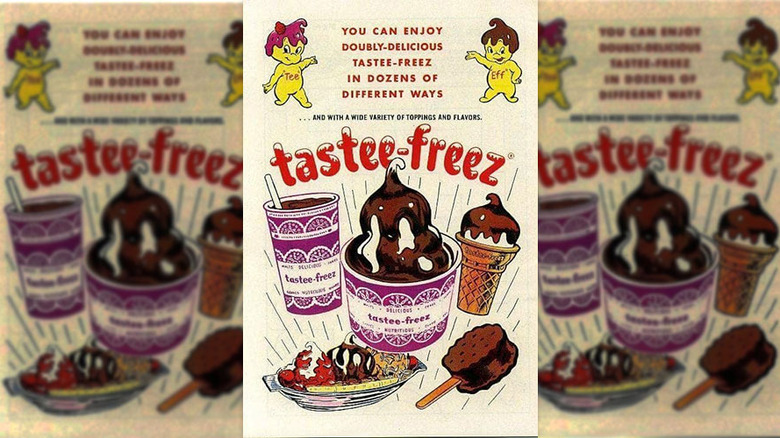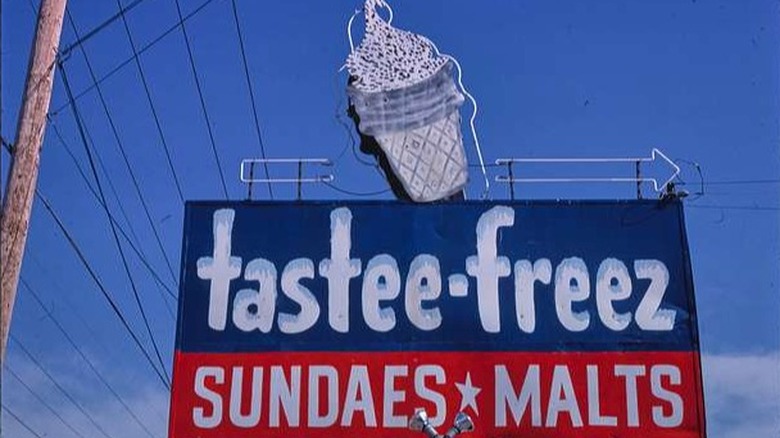The Untold Truth Of Tastee-Freez Ice Cream
With its cool logo and splendid soft serve, served up since the '50s, the recognizable roadside stands of Tastee-Freez have become vintage foodie Americana. In the age of the automobile, stopping off for Tastee-Freez sundaes or cones on a hot summer's day was a classic part of a grand day out or road trip, enjoyed by all the family. Once boasting close to 2,000 franchises when the sweet times were flowing, the untold truth of Tastee-Freez ice cream reveals a rich tale of success, struggle, and rising fortunes.
Alas, few standalone shops are still running today. Bankruptcy followed popularity, and the dessert's history has as many twists and turns as a swirl of soft serve. The tale of what was to become one of the first fast-food chains in the U.S. is a story of engineering ingenuity and the creation of a new food that America fell in love with. Credited as being the brand that put soft serve on the map, the creamy whip is regarded as one of the best fast-food cones around.
What has to be a testament to its terrific taste is its survival through the years, and a chance for generations today to sample a taste of the past and a traditional sugary delight. Tastee-Freez is a wonderfully nostalgic reminder of yesteryear, and a modern-day example of America's soft serve love affair.
Tastee-Freez was born out of an ice cream and engineering dream team
It is doubtful whether the incredible popularity of Tastee-Freez would have been possible without the talents, and determination, of two men. Established in 1950, the company was set up by Harry Axene and Leo Maranz. The Made-in-Chicago Museum, outlines the difficulties Maranz faced in the years before teaming up with Axene. The founder of the Electric Corporation of America, the businessman worked on his ideas for a long time before hitting it big with frozen desserts.
After graduating as a mechanical engineer in Chicago, Maranz began what was to become decades of focus in electric refrigeration. It was during this time, when he was selling ice cream freezers, that he came up with his own version of what was to become the Tastee-Freeze soft serve pump. This ingenious piece of equipment was being sold to entrepreneurs, as Maranz also became involved with helping individuals run their own businesses as well. Meanwhile, his partner, Axene not only had business prowess, but had also worked for what is now a global name in ice cream Dairy Queen. The skills of both men combined was a recipe for franchising success and the perfect opening for Maranz to finally show the world his invention.
Tastee-Freez was a product of the early days of fast food
Tastee-Freez was established in Chicago, at a time when other big-name fast-food outlets were being started. "Fast Food and Junk Food: An Encyclopedia of What We Love to Eat" lists how Dunkin' Donuts and Jack in the Box both came into existence in the same year as Tastee-Freez. Meanwhile, it was just two years later, in 1952, that Harlan Sanders sets up his first Kentucky Fried Chicken franchise.
This was a time of progress, possibility, and a move away from wartime rationing into a period of plenty. While the brand may have peaked as the ice cream version of the American Dream, its appeal was not limited to the U.S. alone. Posters in the early days declared how Tastee-Freez was found, "coast-to-coast and around the world".
Soft serve was something new and exciting for consumers in the '50s and the rapid growth of the company shows that they not only had a great product but an appetizing business plan too. Shops ranged from simple stands to restaurants with seating and were independently owned, with Maranz and Axene making money from renting out the revolutionary pumps. However, the Made-in-Chicago Museum states that it was when the company ventured into England and attempted to set-up the same style of mobile units in the U.S. that profits began to melt away. By 1963, the company filed for chapter 11 bankruptcy and while earning a place in fast-food history this could well have been the end of the road for Tastee-Freez.
Tastee-Freez has a connection to Katie Couric
It was the assistant to Maranz, Herbert Molner who saved the company from extinction, by buying the business and whipping up profits. The man who saved Tastee-Freez from the deep freeze of failed businesses was the father of businessman John Molner who is the husband of TV broadcaster Katie Couric. In many ways, the success of the brand has been about the perseverance and vision of individuals, and of course, the fact that so many people loved the soft serve flavor with its unique taste sensation.
Maranz was no stranger to the fast-food industry, setting up Carrolls, a burger joint named after his daughter (via Syracuse.com). This was to become Carrolls Restaurant Group, which today is Burger King's largest franchisee, not only in the U.S. but globally. Savories were added to the menu, and as with many chains of the day, Tastee-Freez became an appetizing business on the asset plates of larger companies. By the early '80s the company, along with another post-war enterprise, B&K Rootbeer was under the ownership of the Michigan-based Denovo Corporation. Over time, the number of Tastee-Freez stores was reduced as it was gobbled up by the big players.
Ice cream technically wasn't on the menu at Tastee-Freez
It may come as a surprise to some, but the dessert Tastee-Freez was known for, soft serve, might look like ice cream, but it isn't ice cream at all. An article in Eater, suggests there's been something of a resurgence in the popularity of soft serve on restaurant menus. It also explains how soft serve does not contain eggs and is basically made by a special machine that adds-in air. Frozen to a temperature that is not as cold as normal ice cream, the mixture is softer, with an aerated texture. Ice cream or not, there is no doubt that soft serve is creamy tasting and a melt-in-the-mouth joy, and Tastee-Freez was a pioneer in introducing it to a mass fanbase. As a frozen dessert, it's still a firm favorite for sweet-tooths of all ages, even if the brand's old-fashioned parlors and walk-up stands have all but gone.
You've probably heard Tastee-Freez mentioned in a famous classic rock song
For any brand of food to make it into the lyrics of a song is quite something. In 1982, rock musician John Mellencamp captured the flavor of Tastee-Freez as an intrinsic part of American culture in one of his popular tracks. He mentions the brand in a line in the renowned "Jack and Diane". He sings about, "Two American kids growing up in the heartland ... Suckin' on chili dog outside the Tastee-Freez."
With his songs about real people and real life, Tastee-Freez is the perfect backdrop to blue-collar sentiment. In many people's minds, Tastee-Freez was a memorable brand in their neighborhood, and a place where locals, young lovers, and those passing through would stop. Cones and sundaes are evocative of small towns and roadside snack stands across America, where down-to-earth people lived and worked, not a glamorized world of celebrity and high-end, gourmet cuisine. This is exactly what the brand has always been, food for the people, not elite gourmet cusine.
Wienerschnitzel and Tastee-Freez are a match made in fast-food heaven
Wienerschnitzel hotdog franchise and the Original Hamburger Stand, went from selling the Tastee-Freez soft serve in restaurants, to actually owning the business in 2003. The parent company of both, Galardi Group is the present-day owner and in an article on the Wienerschnitzel website the Director of Franchise Development with the hot dog giant, Ted Milburn, discussed why the two brands are a "perfect match."
Milburn remarked, "Tastee-Freez is an iconic brand that millions of people love and connect with -– and what goes better with a chili dog than a soft-serve cone or a shake?" Milburn went on to add, "From a marketing perspective, it's equally advantageous, as we have the opportunity to produce fun new items that make our customers excited to come back. It's a win-win for both our franchise owners and their customers."
Interestingly, the Newport Beach, California Group's founder also started out in the 1950s where according to reports, he got his break into the industry after approaching a man who was hosing down a lot across the street from where he was and asking if he needed any help. That man, it transpires, was Glen Bell Jr. who was to set up none other than the renowned Taco Bell. Meanwhile, Galardi's first hotdog stand was to open in 1961, making him millions before the age of 30. As with Tastee-Freez, Americans ate up this new roadside food designed for a growing grab-and-go culture taking hold.
Alaskan locations stay open even when temperatures drop well below zero
Open all-year-round in Alaska since 1963, the Anchorage Tastee-Freez shop is one of the earliest and was brought to the last frontier in the '50s. This shop became the largest in the country and was a hit with customers who would turn up in sub-zero temperatures via horseback or even sled dog team.
At first, the Alaskan shops were only open during the warmer months, closing in wintertime. However, such was the demand, despite the cold weather, that the opening times were soon extended. One of the stores, the Jewel Lake Tastee-Freez, is the one remaining independent franchise in Alaska. A new franchisee, Lynn Cluff, bought the franchise in 1962 along with two ice-cream trucks. While a 9.2 earthquake in 1964 destroyed one of the shops, according to an account of the history of the franchise, generators from the shop's trucks were even used to help power up the Anchorage airport during the emergency. It was Cluff who first tried to sell sundaes in the snow, setting herself a challenge to sell the frozen dessert in temperatures that plummeted to beyond minus 20F.
Tastee-Freez is involved in a number of community charities
With Reddit comments aplenty, the connection between Tastee-Freez, childhood nostalgia, and community spirit is strong. Generations have worked in family-owned franchises which often became a pivotal meeting point and a must-visit on summer days.
Alaskan owner Rich Owens states in an article in Alaska Business Hall of Fame how the success of the franchise was about the way the business was run with family values at heart. A big believer in giving back to the community, Owen helped with the purchase of a summer camp and with hundreds of disadvantaged teens finding employment. He contributes to Operation Santa Claus with the National Guard, handing out Tastee-Freez sundaes to thousands over the festive period in villages all around. Meanwhile, Galardi Group CEO, Cindy Galardi Culpepper, who took over from her husband in 2013, after her husband passed away is also renowned as a social entrepreneur and philanthropist (via Mirror Review). As well as appearing on an episode of "Undercover Boss," Culpepper has also donated substantial sums to charity and has been involved in various good causes, including building playgrounds for youngsters suffering from cancer. Meanwhile, giving also pays off, with the Group reportedly generating somewhere in the region of an astonishing $290 million in sales across the different brands.
Tastee-Freez had its own line of toys
From baseball figurines to fun clown shakers and so-called "personality dolls," Tastee-Freez treats adds to its vintage appeal with years of promotions and treats for customers. At the Electric Corporation of America, Maranz was focusing on freezers, along with electric fans and fluorescent lights. Yet, perhaps due to wartime restrictions, he shifted his focus on making toys as his main business.
The company anagram, ECA, according to the Made-In-Chicago Museum, was cleverly used to stand for "Educational, Constructive, Artistic." Later, the Tastee-Freez treats on offer included double-wall thermo tumblers, with fun activities such as a presidential coloring competition and contest to paint miniature all-star ballplayer figures. Specials included a tumbler-style, three-piece thermo set with double-walled plastic to keep soft serve desserts cold, with one offer including pin-on child achievement medals. For a child, this combination of getting a goodie and a frozen dessert must have been heavenly. This artistic element was to continue for Maranz after his retirement when he became an artist of some renowned. The geometric look of many of his works echos his engineering background. The posters and offerings presented by Tastee-Freez are collectibles today and are often bought and sold by fans of old-style '50s and '60s Americana.
Who are the Tastee-Freez twins?
A search on any online memorabilia site for the Tastee-Freez twins will probably bring up an image of a salt-and-pepper pot set. Anyone wondering what the connection is between a soft serve frozen dessert and condiments should know that the duo were the brand's mascots and were used in all sorts of promotional ways, including being fashioned into two seasoning shakers which although vintage are still easy to find these days.
The cute and quirky looking pair were used for a time in the '50s where they would stand, at 7.5 feet tall, outside shops to welcome customers with wide smiles and soft serve style hair. Tee, the female twin boasted strawberry-colored hair, while Eff, her male sibling, sported a chocolate topping. The pair were also featured in several editions of Tastee-Freez Comics along with other characters. Stories with Tee and Eff inevitably involved the brand, from finding a treasure trove of Tastee-Freez goodies to sharing an edible sculpture made by an artist that is actually a Tastee-Freez sundae.
There is something so deliciously kitsch, in a good way, about big, bold roadside mascots. They conjure up the romanticism of the great American road trips, and ideas about expressing freedom, exploring the open road, and adventure ahead. There is an innocence in the larger-than-life faces of Tee and Eff that goes beyond soft serve ice cream somehow and speaks of the hope that many people had for the future in 1950s America.
Tastee-Freez isn't totally gone or forgotten
There's no doubt that Tastee-Freez is a flavor of another time, especially in the minds of those who remember stopping off by the side of the road for a refreshment pit-stop. However, the brand is neither gone nor forgotten, as Tastee-Freez shops still exist, albeit not quite as prolifically. Today, there are just a few restaurants, in Alaska, Arizona, California, Florida, Illinois, Maryland, North Dakota, South Carolina, and Vermont.
As well as cones, sundaes, and specialties, the soft serve menu also features thick, creamy shakes as well as root beer and soda floats. Freezes offer a chilled cup of soft serve blended with Oreos or candy pieces similar to a McFlurry.
With the Galardi Group at the helm, Tastee-Freez is pumped out across the country in the Wienerschnitzel restaurants, meaning that the celebrated combination of a dog and a frozen dessert can still be enjoyed to this day. It may be that the brand's eye-catching signs will never light up the roads in abundance again, but there's no doubt that Tastee-Freez created a legacy in fast-food history and a brand that brings back fond memories for those old enough to remember it. This is what food is all about, feeling and atmosphere, as well as a time and a place. This is why Tastee-Freez is so cherished as a sweet treat of bygone days by those who know the name and remember just how darn good it tastes, especially with a chilli dog.
